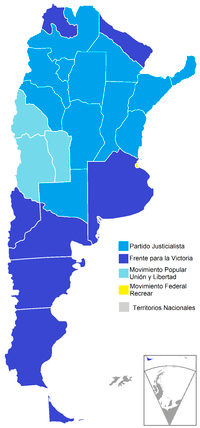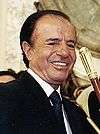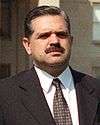Argentine general election, 2003
|
| |||||||||||||||||||||||||||||||||||||||||||||||||||||||||||||||||||||||||
| |||||||||||||||||||||||||||||||||||||||||||||||||||||||||||||||||||||||||
| Registered | 25,481,410 | ||||||||||||||||||||||||||||||||||||||||||||||||||||||||||||||||||||||||
|---|---|---|---|---|---|---|---|---|---|---|---|---|---|---|---|---|---|---|---|---|---|---|---|---|---|---|---|---|---|---|---|---|---|---|---|---|---|---|---|---|---|---|---|---|---|---|---|---|---|---|---|---|---|---|---|---|---|---|---|---|---|---|---|---|---|---|---|---|---|---|---|---|---|
| Turnout | 78.22% | ||||||||||||||||||||||||||||||||||||||||||||||||||||||||||||||||||||||||
| |||||||||||||||||||||||||||||||||||||||||||||||||||||||||||||||||||||||||
 | |||||||||||||||||||||||||||||||||||||||||||||||||||||||||||||||||||||||||
| |||||||||||||||||||||||||||||||||||||||||||||||||||||||||||||||||||||||||
Argentina held presidential and parliamentary elections on Sunday, April 27, 2003. Turnout was 78.2%. No one presidential candidate gained enough votes to win outright, but the scheduled runoff was canceled when first-round winner Carlos Menem pulled out, handing the presidency to runner-up Néstor Kirchner.
Background
For the first time since the return of democracy in 1983, the Justicialist Party (PJ) failed to agree on a single presidential candidate. Three credible Peronist candidates ran in the election: center-right former President Carlos Menem, center-left Santa Cruz Province Governor Néstor Kirchner, and centrist San Luis Province Former president Adolfo Rodríguez Saá.[1] None were officially supported by the party, though President Eduardo Duhalde publicly endorsed Governor Kirchner on January 15, 2003. The PJ suspended its January 24 convention, opting to allow the three contenders to run on the Peronist mantle. None of the candidates were allowed to use the traditional Peronist iconography in detriment of the others.[1]
For the first time since 1916, the UCR did not field a presidential candidate.[1] After the political collapse at the peak of the economic crisis that led to the resignation of President Fernando de la Rúa at the end of 2001, popular support for the UCR was at historically low levels. Two strong former members of the UCR founded parties based on their politics: Congresswoman Elisa Carrió founded a left-of-center party, the ARI, and economist Ricardo López Murphy founded a right-wing one, Recrear.
These five strong candidates were practically tied in all the pre-election polls. Menem obtained the most votes in the first round, but far short of a first-round victory (about 25%), so a runoff election against Kirchner was required, and was scheduled for May 18. However, after two terms in office from 1989 to 1999, Menem's popularity remained very low. All signs pointed to a record victory for Kirchner (polls showed him leading Menem by anywhere from a 35 to a 50% margin).[2][3][2] Rather than face a humiliating defeat, Menem withdrew from the runoff on May 14, a move that was roundly criticized by the other candidates.[4][3] The courts refused to authorize a new election, and also refused to sanction a runoff between Kirchner and López Murphy (though the latter let it be known he would not take part in any case). Finally, Congress sanctioned Kirchner as president-elect, with the lowest vote share ever recorded for a president in a free election.
Legislative races
Legislative and gubernatorial elections were held throughout 2003, with polls open in different provinces between April and November; average turnout was 70.8%.[5]
These elections were unprecedented in their staggered scheduling; indeed, legislators and governors were chosen over 15 different dates, during 2003. They were also, however, a return to political normalcy following a chaotic and economically depressed 2002.
The Justicialist Party, which was divided among three candidates in the presidential race, remained largely united in legislative and local races. They added 12 seats in the Argentine Chamber of Deputies, as well as 2 governorships, and fears of a high number of dissident tickets did not materialize.
The centrist Radical Civic Union, senior partners in the ill-fated Alliance that had returned them to power in 1999, were left with their smallest representation since 1954, though they were not replaced by the center-left ARI in a significant way; the ARI added but 2 Congressmen.
Voters sentiment improved over 2001 levels (when the sentiment among many was that "they should all go"), though not significantly. Turnout increased only modestly, and the use of invalid votes declined from 24% to 15% from the tense 2001 elections. Voters in the important Santa Fe Province, in particular, curbed their use of spoiled ballots from 30% to 20%.[6]
Kirchner ended 2003 on a more secure footing than before these local and legislative elections. He benefited from allies such as the new governor of the paramount Buenos Aires Province, Felipe Solá, as well as the Mayor of Buenos Aires, Aníbal Ibarra. Argentina celebrated 20 years of continuous democratic rule on December 10, 2003, with a new government carrying generous numbers of allies in Congress and the provinces, as well as voters' high expectations.[6]
Results
President
| Presidential candidate |
Vice Presidential candidate |
Party or coalition | First round | Second round | |||
|---|---|---|---|---|---|---|---|
| Votes | % | Votes | % | ||||
| Carlos Menem | Juan Carlos Romero |
|
4,741,202 | 24.45 | Withdrew | ||
| Néstor Kirchner | Daniel Scioli |
|
4,313,131 | 22.25 | Winner | ||
| Ricardo López Murphy | Ricardo Gómez Diez | Alianza Movimiento Federal
para Recrear el Crecimiento
|
3,173,584 | 16.37 | |||
| Adolfo Rodríguez Saá | Melchor Posse | Alianza Frente Movimiento
Popular-Unión y Libertad
|
2,736,091 | 14.11 | |||
| Elisa Carrió | Gustavo Gutiérrez |
|
2,723,207 | 14.05 | |||
| Leopoldo Moreau | Mario Losada | Radical Civic Union | 543,373 | 2.34 | |||
| Patricia Walsh | Marcelo Parrilli | Alianza Izquierda Unida
|
332,703 | 1.72 | |||
| Alfredo Bravo | Rubén Giustiniani | Socialist Party | 217,387 | 1.12 | |||
| Jorge Altamira | Eduardo Salas | Workers' Party | 139,402 | 0.72 | |||
| Enrique Venturino | Federico Pinto Kramer | Confederación para que se Vayan Todos | 129,782 | 0.67 | |||
| Guillermo Sullings | Liliana Ambrosio | Humanist Party | 105,705 | 0.55 | |||
| José Carlos Arcagni | Marcelo Zenof | Alianza Tiempos de Cambio
|
63,386 | 0.33 | |||
| Mario Mazziteli | Adrián Camps | Authentic Socialist Party | 50,303 | 0.26 | |||
| Carlos Zaffore | Fabiana Perie | Integration and Development Movement | 47,954 | 0.25 | |||
| Manuel Herrera | Eduardo Cúneo | Christian Democratic Party | 47,755 | 0.25 | |||
| Gustavo Breide Obeid | Ramiro Vasena | Peoples Reconstruction Party | 42,461 | 0.22 | |||
| Juan Ricardo Mussa | Roberto Suárez | Alianza Unidos o Dominados
|
39,505 | 0.20 | |||
| Ricardo Terán | José Alejandro Bonacci | Movement for Dignity and Independence | 31,766 | 0.16 | |||
| Total | 19,388,697 | 100 | |||||
| Positive votes | 19,388,697 | 97.28 | |||||
| Blank votes | 196,563 | 0.99 | |||||
| Invalid votes | 345,651 | 1.73 | |||||
| Turnout | 19,930,911 | 78.22 | |||||
| Abstentions | 5,550,499 | 21.78 | |||||
| Registered voters | 25,481,410 | 100 | |||||
| Source: Dirección Nacional Electoral - Recorriendo las Elecciones de 1983 a 2013 | |||||||
Argentine Congress
| Party/Electoral Alliance | Lower House Seats |
% of votes | Senate |
|---|---|---|---|
| Justicialist Party | 129 | 36.3% | 41 |
| UCR | 54 | 14.2% | 16 |
| ARI | 13 | 8.0% | |
| Popular Movement for Buenos Aires (Buenos Aires Province) |
9 | 3.9% | |
| Commitment to Change (City of Buenos Aires) |
5 | 4.0% | |
| Strength of Buenos Aires Alliance (City of Buenos Aires) |
4 | 1.5% | |
| Renewal Front Alliance (Misiones Province) |
4 | 1.1% | |
| Neuquén People's Movement (Neuquén Province) |
4 | 0.6% | 2 |
| Self-determination and Freedom | 4 | 1.3% | |
| New Front Alliance (Córdoba Province) |
3 | 2.7% | 1 |
| Republican Force (Tucumán Province) |
3 | 0.8% | 2 |
| Others | 25 | 25.6% | 10 |
| Invalid votes | 14.5% | ||
| Total | 257 | 100.0% | 72 |
Governors and Mayor of Buenos Aires
Provincial officials in all districts except Corrientes Province, were elected, as well as the Chief of Government of the City of Buenos Aires. The Justicialist Party wrested two governorships from the UCR (Chubut and Entre Ríos Provinces), and the UCR recovered Tierra del Fuego from the Justicialists.[8]
| District | Elected Governor | Party | % | Runner-up | Party | % |
|---|---|---|---|---|---|---|
| Buenos Aires | Felipe Solá | Justicialist | 43.3 | Luis Patti | Federalist Unity Party | 13.3 |
| Catamarca | Eduardo Brizuela del Moral | Civic Social Front (UCR) | 50.8 | Luis Barrionuevo | Justicialist Front | 43.5 |
| Chaco | Roy Nikisch | UCR | 53.4 | Jorge Capitanich | Front for Victory | 40.9 |
| Chubut | Mario Das Neves | Justicialist | 45.6 | José Lizurume L | UCR | 41.2 |
| City of Buenos Aires1 | Aníbal Ibarra R | Great Front | 53.5 | Mauricio Macri | Commitment to Change | 46.5 |
| Córdoba | José Manuel de la Sota R | Justicialist | 51.8 | Oscar Aguad | UCR | 37.2 |
| Entre Ríos | Jorge Busti | Justicialist | 44.6 | Sergio Varisco | Social Front Alliance | 34.4 |
| Formosa | Gildo Insfrán R | Justicialist | 71.8 | Gabriel Hernández | Front for All | 24.4 |
| Jujuy | Eduardo Fellner R | Justicialist | 55.8 | Gerardo Morales | UCR | 35.2 |
| La Pampa | Carlos Verna | Justicialist | 49.1 | Francisco Torroba | Alternative Front | 25.5 |
| La Rioja | Ángel Maza R | Justicialist | 55.4 | Jorge Yoma | Work and Production Front | 43.4 |
| Mendoza | Julio Cobos | UCR | 42.9 | Guillermo Amstutz | Justicialist | 35.7 |
| Misiones | Carlos Rovira R | Renewal Front | 47.9 | Ramón Puerta | Justicialist | 32.4 |
| Neuquén | Jorge Sobisch R | Neuquén People's Movement | 56.1 | Aldo Duzdevich | Justicialist | 19.9 |
| Río Negro | Miguel Saiz | UCR | 32.6 | Julio Arriaga | Great Front | 20.4 |
| Salta | Juan Carlos Romero R | Justicialist | 49.7 | Andrés Zottos | Salta Renewal Party | 24.4 |
| San Juan | José Luis Gioja | Justicialist | 41.4 | Roberto Basualdo | Life and Commitment Front | 30.8 |
| San Luis | Alberto Rodríguez Saá | Justicialist | 90.1 | Marcelo Shortrede | Fatherland and Family Movement | 5.5 |
| Santa Cruz | Sergio Acevedo | Justicialist | 70.9 | Anselmo Martínez | Convergence for Santa Cruz | 27.9 |
| Santa Fe | Jorge Obeid | Justicialist | 43.2 | Hermes Binner | Socialist Party | 38.3 |
| Santiago del Estero2 | Mercedes Aragonés de Juárez R | Justicialist | 68.1 | José Luis Zavalía | UCR | 13.0 |
| Tierra del Fuego | Jorge Colazo | UCR | 52.8 | Carlos Manfredotti L | Justicialist | 47.2 |
| Tucumán | José Alperovich | Justicialist | 44.4 | Esteban Jerez | Union for Tucumán | 25.8 |
| ||||||
References
- 1 2 3 Fraga, Rosendo (2010). Fin de ciKlo: ascenso, apogeo y declinación del poder kirchnerista. Ediciones B. pp. 21–23.
- 1 2 "Menem pierde el invicto y la fama". Página/12.
- 1 2 Uki Goñi (May 15, 2003). "Menem bows out of race for top job". The Guardian. Retrieved May 22, 2016.
- ↑ Todo Argentina: Kirchner (in Spanish)
- 1 2 Andy Tow's Electoral Atlas of Argentina
- 1 2 Todo Argentina: 2003 (in Spanish)
- ↑ Argentine Interior Ministry Archived 2009-10-14 at the Wayback Machine.
- ↑ "Gobernador electo (2003)". Atlas Electoral de Andy Tow.

.jpg)


.jpg)